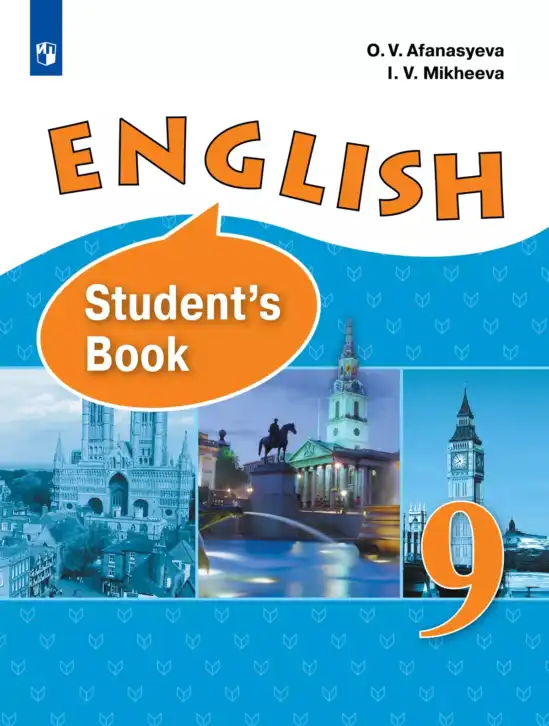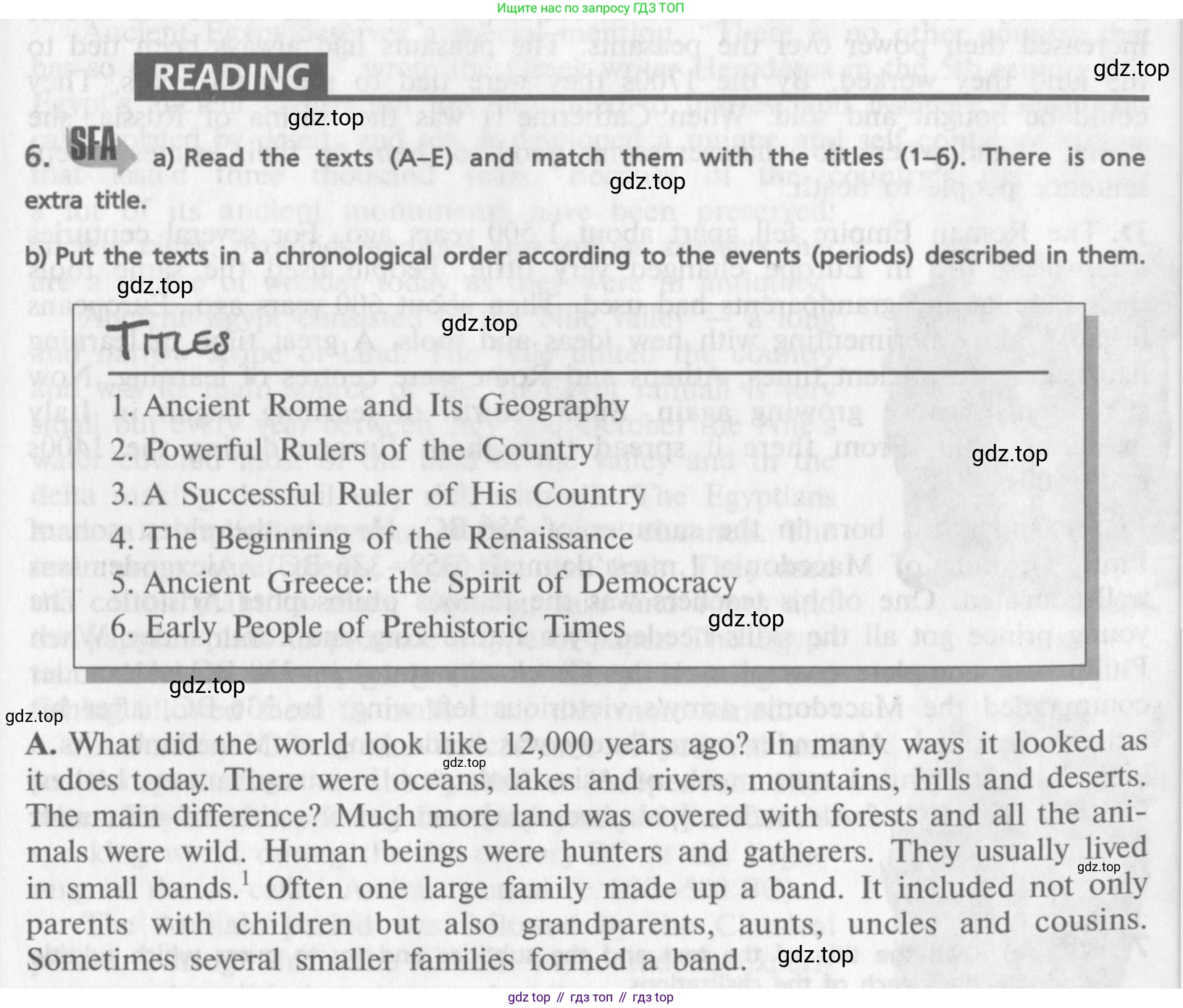Номер 6, страница 9 - гдз по английскому языку 9 класс учебник Афанасьева, Михеева

Авторы: Афанасьева О. В., Михеева И. В.
Тип: Student's book (Учебник)
Издательство: Просвещение
Год издания: 2014 - 2025
Уровень обучения: углублённый
Цвет обложки: голубой, белый
ISBN: 978-5-09-034231-5
Рекомендовано Министерством образования и науки Российской Федерации
Популярные ГДЗ в 9 классе
Unit 1. Pages of history: linking past and present. Reading - номер 6, страница 9.
№6 (с. 9)
Условие. №6 (с. 9)
скриншот условия


READING
6. a) Read the texts (A–E) and match them with the titles (1–6). There is one extra title.
b) Put the texts in a chronological order according to the events (periods) described in them.
Titles
1. Ancient Rome and Its Geography
2. Powerful Rulers of the Country
3. A Successful Ruler of His Country
4. The Beginning of the Renaissance
5. Ancient Greece: the Spirit of Democracy
6. Early People of Prehistoric Times
A. What did the world look like 12,000 years ago? In many ways it looked as it does today. There were oceans, lakes and rivers, mountains, hills and deserts. The main difference? Much more land was covered with forests and all the animals were wild. Human beings were hunters and gatherers. They usually lived in small bands.1 Often one large family made up a band. It included not only parents with children but also grandparents, aunts, uncles and cousins. Sometimes several smaller families formed a band.
B. No one knows exactly when that city was founded. According to legends, it is about 2,700 years old. It is possible the stories are true. According to one of them, the city took its name from Romulus, a shepherd king who founded a settlement on the banks of the river Tiber ['taibə] after killing his twin brother Remus. Little is known about the first citizens of that time but the city was built on seven hills and its location gave the city a strong position. It was in a good place for building and controlling roads to the north and south. Those roads helped make the city a trading centre.
C. Russia was ruled by kings and queens called tsars [za:(r)z] and tsarinas [za:'rinəz]. They had much control over their people. They ruled with the help of a few rich families. But a tsar could take away their land if he or she wished to do so. Any coal, iron or minerals found on their land belonged to the tsar. So did any trees that could be used in building ships. By the late 1700s nobles increased their power over the peasants. The peasants had always been tied to the land they worked. By the 1700s they were tied to the landowners. They could be bought and sold. When Catherine II was the tsarina of Russia, she wrote, "Landowners do whatever seems good to them on their estates except sentence people to death."
D. The Roman Empire fell apart about 1,500 years ago. For several centuries afterwards, life in Europe changed very little. People used the same tools their parents and grandparents had used. Then about 600 years ago, Europeans began again experimenting with new ideas and tools. A great time of learning had begun. In ancient times, Athens and Rome were centres of learning. Now such centres were growing again. Such rebirth of learning began in Italy in about 1300. From there it spread throughout Europe during the 1400s and 1500s.
E. Alexander was born in the summer of 356 BC. He was the eldest son of Philip II, king of Macedonia [,mæsɪ'dəʊnɪə] (359–336 BC). Alexander was well-educated. One of his teachers was the famous philosopher Aristotle. The young prince got all the skills needed by a future king and commander. When Philip won complete control over the Greek city-states in 338 BC, Alexander commanded the Macedonia army's victorious left wing. In 336 BC, after his father was killed, Alexander immediately was made king of Macedonia. As a king Alexander ruled over much of Asia, took part in many famous battles, founded the city of Alexandria [,ælɪg'zændrɪə] and got the title of Alexander the Great.
Решение. №6 (с. 9)


Решение 2. №6 (с. 9)
6. а) Прочитайте тексты (A-E) и сопоставьте их с заголовками (1-6). Один заголовок лишний. б) Расположите тексты в хронологическом порядке в соответствии с описанными в них событиями (периодами).
Ответ:
a)
A - 6: Early People of Prehistoric Times / Ранние люди доисторических времен
B - 1: Ancient Rome and Its Geography / Древний Рим и его география
C - 2: Powerful Rulers of the Country / Могущественные правители страны
D - 4: The Beginning of the Renaissance / Начало эпохи Возрождения
E - 3: A Successful Ruler of His Country / Успешный правитель своей страны
Extra title: 5. Ancient Greece: the Spirit of Democracy / Лишний заголовок: 5. Древняя Греция: дух демократии
b)
The chronological order is: A, B, E, D, C. / Хронологический порядок: A, B, E, D, C.
Другие задания:
Помогло решение? Оставьте отзыв в комментариях ниже.
Присоединяйтесь к Телеграм-группе @top_gdz
ПрисоединитьсяМы подготовили для вас ответ c подробным объяснением домашего задания по английскому языку за 9 класс, для упражнения номер 6 расположенного на странице 9 к Учебник (Student's book) 2014 года издания для учащихся школ и гимназий.
Теперь на нашем сайте ГДЗ.ТОП вы всегда легко и бесплатно найдёте условие с правильным ответом на вопрос «Как решить ДЗ» и «Как сделать» задание по английскому языку к упражнению №6 (с. 9), авторов: Афанасьева (Ольга Васильевна), Михеева (Ирина Владимировна), ФГОС (старый) углублённый уровень обучения учебного пособия издательства Просвещение.















